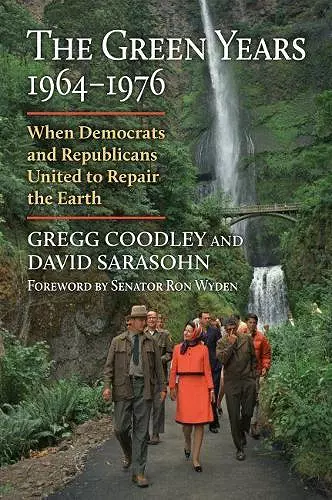The Green Years, 1964-1976
When Democrats and Republicans United to Repair the Earth
Gregg Coodley author David Sarasohn author
Format:Hardback
Publisher:University Press of Kansas
Published:30th Sep '21
Should be back in stock very soon

In The Green Years, 1964-1976, Gregg Coodley and David Sarasohn offer the first comprehensive history of the period when the US created the legislative, legal, and administrative structures for environmental protection that are still in place over fifty years later. Coodley and Sarasohn tell a dramatic story of cultural change, grassroots activism, and political leadership that led to the passage of a host of laws attacking pollution under President Johnson. At the same time, with Stewart Udall as secretary of the interior, the Wilderness Act, the Wild and Scenic Rivers Act, and other land-protection measures were passed and the department shifted its focus from western resource development to broader national conservation issues. The magnitude of what was accomplished was without precedent, even under conservation-minded presidents like the two Roosevelts. The fast-paced story the authors tell is not only about the Democratic Party; in this era there was still a vital Republican conservation tradition. In the 1960s, Republicans were chronologically as close to Teddy Roosevelt as to Donald Trump. In both the House and Senate and in the Nixon and Ford administrations, Republicans played vital roles. It was President Nixon who established the Environmental Protection Agency and signed into law the 1970 Clean Air Act, revisions in 1972 to the Clean Water Act, and the 1973 Endangered Species Act. Under Nixon, actions were taken to protect the oceans, forests, coastal zones, and grasslands while regulating chemicals, pesticides, and garbage.
The authors analyze the full range of transformations during the “Green Years,” from the creation of entirely new pollution-control industries to backpacking becoming mass recreation to how revelations about chemical exposure spurred the natural food movement. And not least, the tectonic shift in the political landscape of the United States with the western states becoming Republican bastions and centers of ongoing backlash against the federal government. The Green Years, 1964-1976, is the story of environmental progress in the midst of war and civil unrest, and of the lessons we can learn for our future.
The Green Years is vivid, thoroughly researched, and authentic. Brings you into that era. Absorbing and full of insights." - Michael McCloskey, chairman (retired), Sierra Club
"As we face the crisis of climate change, this important history of earlier environmental legislation helps us remember that organized movements can persuade even the most recalcitrant politicians to reshape their legislative agendas. The Green Years is a very compelling story." - Barbara Dudley, former executive director, Greenpeace USA
"This book is an ambitious narrative history of environmental politics and policy in the 1960s and 1970s. The Green Years is the most comprehensive history of environmentalism’s legislative achievements during its most fruitful period." - Robert D. Lifset, author of Power on the Hudson: Storm King Mountain and the Emergence of Modern American Environmentalism
"The Green Years, 1964–1976, offers a detailed, well-documented, and thoroughly rewarding history of a unique period in US environmental policymaking. In the 1960s and 1970s, the federal government approved most of the modern conservation and environmental protection policies, typically with broad bipartisan cooperation. Given today’s often intense partisan polarization over many of the same issues, the book’s careful review of major policy decisions of that period speaks to what it takes to achieve that kind of bipartisanship today." - Michael E. Kraft, professor emeritus of political science and public and environmental affairs, University of Wisconsin-Green Bay
"This book is a rich treasure trove that illuminates just how profoundly the polarization of America’s political parties has made more difficult—or arguably impossible—the responsiveness of the federal government to public attitudes and sentiment—the very ingredient that Abraham Lincoln argued was the bedrock of our politics. Today you simply can’t conceive that a presidential candidate of the minority party embracing a new issue—as Muskie did the environment in 1970—would stimulate a race to be even more responsive by the incumbent party, as Nixon did. Nixon was looking for bridges, not wedges. And that’s why we made the environmental progress we did. We need a new politics if we want to resume that path forward." - Carl Pope, former executive director, Sierra Club
ISBN: 9780700632343
Dimensions: 233mm x 157mm x 34mm
Weight: 725g
375 pages